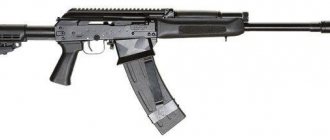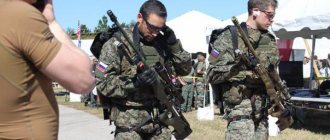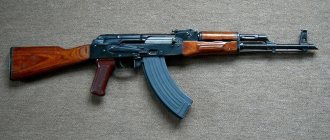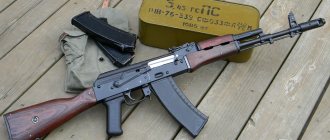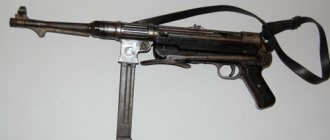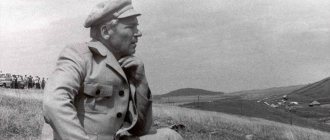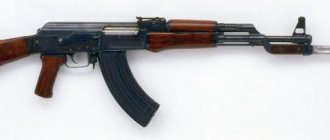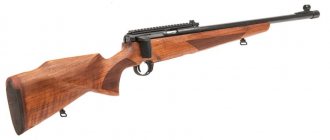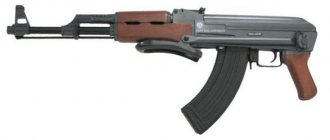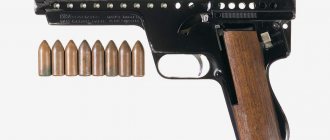Kalashnikov prepared AK-400 for special forces
The Kalashnikov Concern, whose main production facilities are located in Izhevsk, has disclosed information about its new model - the AK-400 assault rifle, which was developed by the company’s specialists and is offered for arming elite Russian special forces, which include the Special Purpose Center of the FSB of Russia (Vympel and "Alpha"), as well as the Presidential Security Service. It is reported that the new assault rifle is a further development of the Kalashnikov assault rifles of the so-called “hundredth” series, while the AK-400 is offered in several versions for different cartridges. It is reported that the new AK-400 assault rifle was first presented at a closed meeting organized by the Presidential Security Service at the end of 2015, where the new product aroused interest from representatives of law enforcement agencies, and currently this type of automatic weapon is under study by potential customers , which are the special forces of the FSB and the FSO of Russia. In particular, the Izvestia newspaper wrote about this on May 19, 2016, citing its own source in the Russian military-industrial complex.
Another Izhevsk assault rifle, the AK-12, which was previously proposed as a promising development for inclusion in the new generation of “Ratnik” combat equipment, does not fully meet the requirements of elite Russian special forces. AK-12 is an army weapon, a weapon of infantrymen and paratroopers. Special forces fighters need a more compact machine gun, which, on the one hand, would not be inferior to the AK-12 in accuracy and shooting accuracy, on the other hand, would be small enough so that it could be used to successfully storm houses, trains, planes and buses , skydiving, etc.
At the same time, the AK-400 proposed to the special services employees is an “adaptive” machine gun, since it allows a fighter not only to install any sight, laser designator or tactical flashlight on the weapon, but also to adjust their position depending on his own physiological characteristics. It is expected that the total length of the machine gun will be no more than 940 mm, and it will weigh a little more than 3 kilograms. One of the interesting features of the machine is the appearance of the “cut-off” firing mode, which allows you to fire in bursts of 3 shots. The AK-400 assault rifle was also equipped with a telescopic folding stock. A fighter can quickly shorten or lengthen the stock, and by folding it completely, he will receive a very compact automatic weapon, which is convenient to handle both in a car and in rather cramped spaces.
The opportunity to get acquainted with the AK-400 assault rifle in early May 2016 was given to the American Larry Vickers, a former soldier of the 1st Special Forces Detachment Delta and a shooting instructor of the American army, who currently runs his own weapons video channel Vickers Tactical on YouTube. It is worth noting that Vickers is a long-time fan of Russian small arms. Today on his channel you can find a fairly large number of videos about the newest models of Russian weapons, such as the AK-12 and AK-107 assault rifles, the PL-14 pistol, the SV-338 rifle and many others.
On his Vickers Tactical channel, on May 2, 2016, he published a 2.5-minute video that talks about the characteristics and features of the AK-400, and also demonstrates shooting from the new machine gun. The first conclusion that can be drawn after watching this video is that we are talking about a deep modernization of the Kalashnikov assault rifle, as well as the creation of a whole family of “400 series” models. In all likelihood, it will also include a new light machine gun, which has the code name RPK-16 (with a weighted barrel, bipod and drum magazine). This weapon was presented in the program “Serving the Fatherland” last fall. In addition, the AK-400 is created in two calibers at once: for the more modern low-pulse cartridge 5.45x39 mm and the old Soviet cartridge 7.62x39 mm model 1943. The machine gun sample that Larry Vickers tested had a caliber of 7.62 mm and weighed 3.1 kilograms with a total length of 942 mm. The machine's rate of fire is 600 rounds/min, like most modern AK variants.
Apparently, the compact AK-104 assault rifle of the so-called “hundredth series” was chosen as the base model for the AK-400, which was lengthened to the size of an ordinary AK-74M, but has a number of design changes. Firstly, the new polymer telescopic stock, adjustable in length and folding to the left, immediately attracts attention. It was borrowed from the modernization kit for Kalashnikov KM-AK assault rifles, which was developed by the concern on its own initiative within the framework of the “Kobves” research and development project according to the technical specifications of the Russian Ministry of Defense.
The idea of installing such a stock on a machine gun is far from new and has been practiced for quite some time by many foreign companies, such as CAA, FAB Defense, Magpul and many others. The machine also features a new ergonomic pistol grip, which is hollow and can be used to store accessories for cleaning weapons. The creators of the AK-400 assault rifle also redesigned the receiver cover, which was made in the style of the AKC-74U hinged cover, thanks to better stability and the presence of a long Picatinny mounting rail MIL-STD-1913, it can be used for mounting various day and night optical, as well as collimator sights. The same, but shorter, Picatinny rails are placed on a recycled plastic forend of the machine gun, giving the fighter the opportunity to install various accessories on the weapon in the form of laser designators, a tactical flashlight, handles, laser shooting simulators, etc. Thanks to such solutions, the AK-400 will allow the fighter avoid unnecessary hassle of “tuning” weapons.
Like the AK-104, the front sight on the AK-400 was moved to a gas chamber, like most modern Western assault rifles. Finnish gunsmiths introduced a similar solution on the Valmet Rk.62 assault rifle, which was adopted by the Finnish army back in 1962. On the AK-400, the sector sight gave way to a diopter sight with a reversible rear sight, located in the rear of the receiver. A new muzzle brake-compensator has also appeared on the machine gun, which allows you to shoot foreign-made rifle grenades. For the same purpose, a two-position regulator was included in the design of the side gas engine, which further facilitates cleaning of the gas chamber.
The trigger mechanism used on the AK-400 assault rifle allows firing with a cutoff of 3 shots. Accordingly, the firing mode switch has 4 positions: A - automatic fire, 3 - fire in bursts of 3 rounds, 1 - single fire, P - safety. At the same time, the “cut-off” mode has become a standard solution for the machine, and not an optional feature. The machine is fed from standard sector magazines designed to hold 30 rounds. Despite the fragmentary and paucity of information available today, the new machine makes a good impression on experts. In particular, the website all4shooters.com noted that the AK-400 uses the best foreign and Russian developments in the field of modernization of assault rifles of the AKM/AK-74/AK-100 families, and also demonstrates very good stability of the weapon when firing automatic fire from a standing position , even when using 7.62x39 mm caliber cartridges.
It is noteworthy that a new version of the Kalashnikov assault rifle appeared on the eve of autumn, when the Russian Ministry of Defense must finally decide which model - the Izhevsk AK-12 assault rifle designed by V.V. Zlobin or the Kovrov AEK-971 (A-545/A -762) will be selected based on the results of state tests for further adoption as part of the construction of the “Ratnik” combat equipment set. At the same time, in the tests carried out, the “400th series” demonstrates its superiority. The arrows emphasize the extraordinary accuracy and accuracy of the weapon. According to their reviews, the AK-400 is superior to both the AK-74 assault rifles in service and the modernized AK-12.
At the same time, both the AK-12 and AEK-971 have already been criticized by customers from the Russian Ministry of Defense due to their high cost. In particular, it was said that they both “are significantly more expensive than standard models, for example, the AK-105.” In this regard, it becomes clear the desire of the management of the Kalashnikov concern to have an inexpensive and modern alternative, which could become interesting for export, and after appropriate changes, for the civilian market of small arms. Probably, the appearance of the AK-400 assault rifle was also a consequence of serious technological and personnel changes in the concern’s policy, which have been observed over the past two years. In particular, with the arrival at the enterprise of the chief designer, deputy general director S.V. Urzhumtsev, who previously headed, to whom the success of the Vepr family of carbines and shotguns, quite popular in our country, is largely due, more practicality and practicality appeared in the developments of the Kalashnikov concern. meaningfulness.
Unlike special bullpup assault rifles AC-1/AC-2, as well as AK-12, which were created in a hurry, the AK-400 seems more rational, as it appeared through a natural evolutionary path, representing the reincarnation of earlier projects of the concern. Already now, the weapons that are offered to representatives of the special services may turn out to be much more interesting than the AK-12 and AEK-971 assault rifles, especially from the point of view of their cost and reliability. It is reported that the new AK-400 will be presented to the general public for the first time at the Army 2016 forum, which will be held in the Moscow region in September 2016.
Apparently, the AK-400 can also become the basis for a new ultra-light machine gun (RPK-400), which today is also in demand from the military. It is reported that the Kalashnikov concern has already offered the special services an ultra-light machine gun built on the basis of the AK-400 assault rifle. The Ministry of Defense plans to order a new compact machine gun, comparable in size to the AK-74 assault rifle, but superior to the Pecheneg currently in service in terms of shooting accuracy and rate of fire, to arm special forces, reconnaissance officers, mountain riflemen, and special operations forces. With the new small-sized and light weapons, the listed categories of soldiers will be able to solve the tasks assigned to them much more successfully.
In particular, the military expects to receive machine guns chambered for different cartridges, 7.62 and 5.45 mm, and with different barrel lengths. Thus, a 5.45 mm machine gun is more suitable for operations in populated areas and on the plain, and a 7.62 mm machine gun is more suitable for combat operations in forest and mountainous areas. At the same time, a machine gun with a long barrel can be used to hit targets at long distances, and a short barrel will look better during assault operations. Also, at the request of the Russian Ministry of Defense, the new product will have to receive a tactical handle in the front part of the machine gun, which will allow more accurate fire even while in weight, without the machine gun resting on the bipod and telescopic butt.
Sources of information: https://www.all4shooters.com/ru/strelba/ruzhya/Kontsern-Kalashnikov-AK-400-novaya-model-avtomata https://lenta.ru/news/2016/05/19/ak400 https ://24ri.ru/down/o-261.html https://izvestia.ru/news/616556#ixzz4BgeI1kV5
Notes
- ↑ Manual on shooting. 7.62 mm modernized Kalashnikov assault rifle (AKM and AKMS). — 3rd ed. - M.: Voenizdat, 1983. - 160 p., ill.
- Blagovestov A.I.
What they shoot from in the CIS: Directory of small arms / Under the general editorship of A.E. Taras. - Mn.: “Harvest”, 1999 - 656 p. "Commando". ISBN 985-433-521-6 - Shooting manual. 7.62 mm Kalashnikov assault rifle (AK). — 2nd ed. - M.: Voenizdat, 1958. - 160 p., ill.
- Shooting manual. 7.62-mm Degtyarev light machine gun (RPD). — 2nd ed. - M.: Voenizdat, 1957. - 152 p., ill.
- Shooting manual. 7.62 mm Simonov self-loading carbine (SKS). — 2nd ed. - M.: Voenizdat, 1962. - 136 p., ill. — P. 131.
- ↑ Dockery, Kevin.
Future Weapons (undefined). - New York, NY, USA: Berkley Publishing Group (English) Russian, 2007. - ISBN 978-0-425-21215-8. - ↑ Rottman, Gordon (2011). The AK-47 Kalashnikov series assault rifles
. Great Britain: Osprey Publishing. ISBN 978-1-84908-461-1. - ↑ Jones, Richard D. Jane's Infantry Weapons 2009/2010
. Jane's Information Group; 35 edition (January 27, 2009). ISBN 978-0-7106-2869-5. - Gander, Terry J.; Hogg, Ian V. Jane's Infantry Weapons 1995/1996
. Jane's Information Group; 21 edition (May 1995). ISBN 978-0-7106-1241-0. - ↑
- . fas.org. Retrieved November 20, 2009.
- John Pike.
. Globalsecurity.org (April 27, 2005). Retrieved November 20, 2009. - . Automats-in-action.com. Retrieved November 20, 2009.
- Jeff Freeman.
. home.comcast.net. Retrieved November 20, 2009. - . Small Arms Survey
. Geneva, Switzerland: Graduate Institute of International and Development Studies. Retrieved June 17, 2014. - (unavailable link). Mil.fi (May 20, 2009). Retrieved November 20, 2009.
- Jurado, Carlos Caballero.
Central American Wars 1959-89 (unspecified). - London: Osprey Publishing, 1990. - P. 20, 45. - (Men-at-Arms 221). — ISBN 9780850459456. - . Zastava-arms.co.rs.
Where is it sold?
Nowadays, it is much easier to purchase weapons than in years past. There are completely official methods of sale, in which almost any sample can be registered as a sporting or hunting “barrel”. But there is another way.
Over the past two decades, many armed conflicts and wars have raged on the territory of the former Union, during which control of the safety of property in army warehouses was almost impossible. Firing from a Kalashnikov assault rifle has become a familiar background sound for residents of many previously calm and peaceful regions, and its presence in the house has acquired the character of possessing an ordinary household item necessary in the household. This was the case in Nagorno-Karabakh, Chechnya, Transnistria, Ossetia, Abkhazia and other areas of the previously united country. Depending on the availability and number of unregistered “barrels”, the price for which you can buy a Kalashnikov assault rifle on the black market is determined. It usually ranges from 400 to 1500 US dollars, depending on the technical condition, model and country of origin. Caliber also matters. Together with the degree of availability of ammunition, it affects the amount that the owner asks for per unit. Soviet-style weapons were produced in different countries, sometimes under official license, and sometimes counterfeit. The technology is simple, its organization does not require very complex equipment, but in terms of the use of special alloys and high-quality steels, the real Russian Kalashnikov assault rifle behaves best. Its price is usually higher than Chinese, sometimes twice or more. They also charge a lot for shortened modifications - they are favored by criminal groups, while in real combat conditions the AK-47 or AK-74 behaves more reliably. Conventional versions have fewer failures and the barrel overheats to a lesser extent. But, as they say, to each his own.
Contender for victory – Sudaev
The proposal of the NPO competition, whose chairman was also Supreme Commander-in-Chief J.V. Stalin, assumed the unconditional participation of all defense enterprises involved in the design of small arms. But there was no longer any need to urge Soviet engineers, they were already working at full capacity in three directions at once. Engineers created an automatic rifle (that’s what an automatic carbine chambered for a rifle cartridge was called in the USSR), a rapid-fire hand-loading carbine and a self-loading carbine. As of the summer of 1944, among other designs, the Sudaev assault rifle (AS-44) was in the lead. They did not have time to launch it into production until the end of the war, but it underwent practical tests in East Germany immediately after the Victory, and, by and large, they were crowned with success. The complaints of the servicemen of the Western Group of Soviet Forces, who held it in their hands and fired from it, boiled down mainly to its heaviness. The competition was extended until 1946, there was nowhere to rush, and only the optimal model should be accepted into service.
